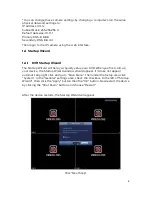
13
If you have an NVR, you must set the IP address of the NVR in the same range as
your IP cameras.
Example: If your IP camera’s IP address is 192.168.0.120 the rest of you network
device IP addresses (including the NVR) will need to be 192.168.1.x to function
properly. Therefore if your router’s IP address is 192.168.0.1 and other network
devices are set in a range of 192.168.0.x but your NVR’s network settings are set to
IP address 192.168.1.223 with a default gateway of 192.168.1.1 (as shown in picture
above), then the IP camera will not be able to connect to the NVR. In that case you
would need to set your NVR’s network settings to 192.168.0.223 and the default
gateway to 192.168.0.1. Similarly if your IP camera was set to a 192.168.1.x IP
address and the network devices and NVR were set IP addresses in the range of
192.168.0.x then you would need to change the IP camera to be in the 192.168.0.x
IP range.
If your your network supports DHCP, you can click the DHCP box. This allows your
router to assign an IP address to your DVR automatically.
Note: When setting a device’s IP address, it is important to choose an address that
is not currently in use by another device. If two devices are assigned the same IP
address, this will cause a conflict and both devices may not function properly on
the network.
Click “Next”.














































